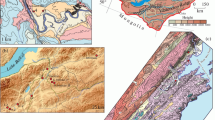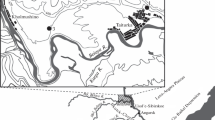Abstract
Carbonate coatings formed on the lower surfaces of pebble inclusions in the Holocene-Late Pleistocene sediments on the Irkutsk-Cheremkhovo Plain have been studied. The coupled analysis of the carbon isotope composition of the soil organic matter and carbonate coatings has indicated the formation of coatings under conditions of phytocenoses with the predominance of C3 plants. A significant effect of the atmospheric CO2 on the carbon isotope composition in the coatings has been noted, which could be related to their formation under low soil respiration rates. The latter was apparently due to the periodic freezing of the soil, which affected the structure of the coatings and was most manifested in the formation of spherulites in their outer layers. The carbonate coatings consist of two laminae significantly differing in their structure and stable isotope composition, which allows separating two main stages of their formation. The lightening of the carbon isotope composition in the outer (younger) layers of the coatings compared to their inner (older) ones coincides with the increase of the δ18O values, which points to changes of the environmental conditions in the studied area during the formation of the coatings.
Similar content being viewed by others
References
Agroclimatic Reference Book of Irkutsk Oblast (Gidrometizdat., Leningrad, 1962) [in Russian].
E. V. Arinushkina, Handbook on the Chemical Analyses of Soils (Izd. Mosk. Gos. Univ., Moscow, 1970) [in Russian].
G. A. Vorob’eva, “Paleogeographic conditions of the formation and stratification of the deposits of Sosnovyi Bor, a multilayered monument of the Stone Age in the south of Central Siberia,” in Paleoethnological Investigations in the South of Central Siberia (Izd. Irkutsk Gos. Univ., Irkutsk, 1991), pp. 15–25 [in Russian].
G. A. Vorob’eva, Soil as a Record of Environmental Events in the Baikal Region and the Problems of Soil Evolution and Soil Classification (Izd. Irutksk. Gos. Univ., Irkutsk, 2010) [in Russian].
G. A. Vorob’eva, Kh. A. Arslanov, N. E. Berdnikova, N. V. Vashukevich, Yu. V. Ryzhov, N. V. Chaika, “Sediments of the Karginsk soils in sections of geoarchaeological objects in the southern Baikal region,” in Ancient Cultures of Mongolia and Baikal Siberia Mater. Int. Conf. (Izd. Irkutsk. Gos. Univ., Irkutsk, 2011), Vol. 2, pp. 49–57 [in Russian].
G. A. Vorob’eva, G. I. Medvedev, E. O. Rogovskoi, E. A. Lipina, P. N. Rebrikov, M. V. Kudelya, “The study of the Kazantsevskie sediments and included artifacts at Georgievskoe-1 site of the southern Angara region,” in Problems of Archaeology and Ethnography of Siberia and Contiguous Territories (Izd. Inst. Arkheolog. Etnogr. Antropol. SO RAN, Novosibirsk, 1997), pp. 29–36 [in Russian].
Irkutsk-Chermkhovo Industrial Region (Irkutsk, 1969) [in Russian].
Classification and Diagnostic System of Russian Soils (Oikumena, Smolensk, 2004) [in Russian].
Classification and Diagnostic System of Soils of the Soviet Union (Kolos, Moscow, 1977) [in Russian].
I. V. Kovda, “Information significance of carbonate pedofeatures for reconstructing the processes and factors of soil formation,” in Soil Memory: Soil as a Memory of the Biosphere-Geosphere-Anthroposphere Interactions (Izd. LKI, Moscow, 2008) [in Russian].
I. V. Kovda, “Carbonate pedofeatures in soils: old and new problems,” in Soils, Biogeochemical Cycles, and the Biosphere (KMK, Moscow, 2004), pp. 115–136 [in Russian].
A. A. Kozlova and A. P. Makarova, Ecological Factors of Soil Formation in the Southern Cis-Baikal Region (Izd. Irkut. Gos. Univ., Irkutsk, 2012) [in Russian].
V. T. Kolesnichenko, “Water and temperature regimes and agrophysical properties of leached chernozems in the forest-steppe of East Siberia,” in Soils, Fertilizers, and Crop Yields in the Baikal Forest-Steppe (Vost.-Sib. kn. izd., Irkutsk, 1965), pp. 42–60 [in Russian].
G. G. Litvintsev and G. I. Tarakanova, “On the stratigraphy of Quaternary deposits in the Irkutsk Depression,” in Geology and Mineral Deposits of the South of Siberian Platform, (Nedra, Leningrad, 1970), pp. 88–106 [in Russian].
N. A. Logachev, T. K. Lomonosova, and V. M. Klimanova, Cenozoic Deposits in the Irkutsk Depression (Nauka, Moscow, 1964) [in Russian].
E. I. Ravskii, Sediment Accumulation and Climate of the Inner Asia in the Quaternary Period (Nauka, Moscow, 1972) [in Russian].
Ya. G. Ryskov, A. A. Velichko, V. I. Nikolaev, S. A. Oleinik, S. N. Timireva, V. P. Nechaev, P. G. Panin, T. D. Morozova, “Reconstruction of the paleotemperature and precipitation in the Pleistocene according to the isotope composition of humus and carbonates in loess on the Russian Plain,” Eur. Soil Sc. 41(9), 937–945 (2008).
Ya. G. Ryskov and V. A. Demkin, The Development of Soils and Environment in the Steppes of Southern Urals in the Holocene (an Experience in Reconstruction with the Use of the Methods of the Geochemistry of Stable Isotopes) (ONTI PNTs RAN, Pushchino, 1997) [in Russian].
Ya. G. Ryskov, S. V. Mergel’, I. V. Kovda, and E. G. Morgun, “Stable isotopes of carbon and oxygen as indicators of the conditions of formation of pedogenic carbonates,” Pochvovedenie, No. 4, 405–414 (1995).
Reference Book on Climate of the USSR. Meteorological Data on Separate Years. Irkutsk Oblast and Southwestern Buryatia, Iss. 22, Part 2 Atmospheric Precipitation (Irkutsk, 1975) [in Russian].
O. S. Khokhlova, A. A. Khokhlov, O. A. Chichagova, A. M. Kuznetsova, S. A. Oleinik, “Transformation of carbonate pedofeatures in paleosols buried under kurgans in the North Caucasus Region,” Eur. Soil Sci. 41(9), 923–936 (2008).
R. Amundson, O. Chadwick, J. Sowers, and H. Doner, “The stable isotope chemistry of pedogenic carbonates at Kyle Canyon, Nevada,” Soil Sci. Soc. Am. J. 53, 201–210 (1989).
R. Amundson, L. Stern, T. Baisden, and Y. Wang, “The isotopic composition of soil and soil-respired CO2,” Geoderma 82, 83–114 (1998).
V. Andreychouk, B. Ridush, and E. Galuskin, “Pionerka Cave: Conditions and specificity of cryogenic mineral formation,” Speleol. Karstol., No. 2, 54–69 (2009).
M. Catoni, G. Falsone, and E. Bonifacio, “Assessing the origin of carbonates in a complex soil with a suite of analytical methods,” Geoderma 175–176, 47–57 (2012).
T. Cerling, “The stable isotopic composition of soil carbonate and its relationship to climate,” Earth Planet Sci. Lett. 71, 229–240 (1984).
T. Cerling, J. Quade, Y. Wang, and J. Bowman, “Carbon isotopes in soils and paleosols as ecology and paleoecology indicators,” Nature 341, 138–139 (1989).
M.-A. Courty, C. Marlin, L. Dever, P. Tremblay, P. Vachier, “The properties, genesis and environmental significance of calcitic pendents from the High Arctic (Spitsbergen),” Geoderma 61, 71–102 (1994).
T. Desjardins, F. Andreux, B. Volkoff, and C. C. Cerri, “Organic carbon and 13C contents in soils and soil sizefractions, and their changes due to deforestation and pasture installation in eastern Amazonia,” Geoderma 61, 103–118 (1994).
P. Deutz, I. P. Montanez, H. C. Monger, and J. Morrison, “Morphology and isotope heterogeneity of Late Quaternary pedogenic carbonates: implications for paleosol carbonates as paleoenvironmental proxies,” Palaeogeog. Palaeoclim. Palaeoecol. 166, 293–317 (2001).
S. I. Dworkin, L. Nordt, and S. Atchley, “Determining terrestrial paleotemperatures using the oxygen isotopic composition of pedogenic carbonate,” Earth Planet. Sci. Lett. 237, 56–68 (2005).
J. Ferrio, A. Florit, A. Vega, L. Serrano, J. Voltas, “Δ13C and tree-ring width reflect different drought responses in Quercus ilex and Pinus halepensis,” Oecologia 442, 512–518 (2003).
D. Fox and P. L. Koch, “Carbon and oxygen isotopic variability in Neogene paleosol carbonates: constraints on the evolution of C4 grasslands,” Palaeogr. Palaeocl. Palaeoecol. 207, 305–329 (2004).
M. Gocke, K. Pustovoytov, P. Kühn, G. L. B. Wiesenberg, M. Löscher, Y. Kuzyakov, “Carbonate rhizoliths in loess and their implications for paleoenvironmental reconstruction revealed by isotopic composition: δ13C, 14C,” Chem. Geol. 283, 251–260 (2011).
E. Kelly, S. Blecker, C. Yonker, C. Olson, E. Wohl, L. Todd, “Stable isotope composition of soil organic matter and phytoliths as paleoenvironmental indicators,” Geoderma 82, 59–81 (1998).
C. Koerner, G. Farquhar, and S. Wong, “Carbon isotope discrimination by plants follows latitudinal and altitudinal trends,” Oecologia 88, 30–40 (1991).
I. Kovda, C. Mora, and L. Wilding, “Stable Isotope compositions of pedogenic carbonates and soil organic matter in a temperate climate Vertisol with gilgai, Southern Russia,” Geoderma 136, 423–435 (2006).
B. Lacka, M. Lanczont, and T. Madeyska, “Oxygen and carbon stable isotope composition of authigenic carbonates in loess sequences from the Carpathian Margin and Podolia, as a palaeoclimatic record,” Quat. Intern. 198, 136–151 (2009).
B. Liu, F. Phillips, and A. Campbell, “Stable carbon and oxygen isotopes of pedogenic carbonates, Ajo Mountains, Southern Arizona: implications for paleoenvironmental change,” Palaeogeog. Palaeoclimatol. Palaeoecol. 124, 233–246 (1996).
W. Liu, H. Yang, Y. Sun, and X. Wang, “δ13C values of loess total carbonate: a sensitive proxy for Asian summer monsoon in arid northwestern margin of the Chinese Loess Plateau,” Chem. Geol. 284, 317–322 (2011).
M. N. Machette, “Calcic soils of the south-western United States,” Geol. Soc. Am. Spec. Pap, No. 203, 1–21 (1985).
H. Monger, D. Cole, J. Gish, and T. Giordano, “Stable carbon and oxygen isotopes in quaternary soil carbonates as indicators of ecogeomorphic changes in the northern Chihuahuan Desert, USA,” Geoderma 82, 137–172 (1998).
M. Pansu and J. Gautheyrou, Handbook of Soil Analysis: Mineralogical, Organic and Inorganic Methods (Springer, Berlin, 2006), pp. 15–42 (2006).
K. Pustovoytov, “Pedogenic carbonate cutans on clasts in soils as a record of history of grassland ecosystems,” Palaeogeog., Palaeoclimatol. Palaeoecol. 177, 199–214 (2002).
K. Pustovoytov, K. Schmidt, and H. Taubald, “Evidence for Holocene environmental changes in the northern fertile crescent provided by pedogenic carbonate coatings,” Quat. Res. 67, 315–327 (2007).
J. Quade, T. Cerling, and J. Bowman, “Systematic variations in the carbon and oxygen isotopic composition of pedogenic carbonate along elevation transects in the Southern Great Basin, United States,” Geol. Soc. Am. Bull. 101, 464–475 (1989).
J. Quade, C. Garzione, and J. Eiler, “Paleoelevation reconstruction using pedogenic carbonates,” Rev. Mineral. Geochem. 66, 53–88 (2007).
J. Quade, J. Rech, C. Latorre, J. L. Betancourt, E. Gleeson, M. Kalin, “Soils at the hyperarid margin: the isotopic composition of soil carbonate from the Atacama Desert, Northern Chile,” Geochim. Cosmochim. Acta 71, 3772–3795 (2007).
C. Spötl and T. W. Vennemann, “Continuous-flow isotope ratio mass spectrometric analysis of carbonate minerals,” Rap. Comm. Mass Spectrom. 17, 1004–1006 (2003).
Statistical Treatment of Data on Environmental Isotopes in Precipitations Techn. Rep. Ser. No. 331 (Int. Atomic Energy Agency, Vienna, 1992).
L. Tieszen, “Natural variations in the carbon isotope values of plants: implications for archaeology, ecology and paleoecology,” J. Archaeol. Sci. 18, 227–248 (1991).
T. Vogt, “Cryogenic physicochemical precipitations: iron, silica, calcium carbonate,” Permafr. Perigl. Proc. 1, 283–293 (1991).
D. Williams and J. Ehleringer, “Carbon isotope discrimination in three semiarid woodland species along a monsoon gradient,” Oecologia 106, 455–460 (1996).
Author information
Authors and Affiliations
Corresponding author
Additional information
Original Russian Text © V.A. Golubtsov, A.A. Cherkashina, K.E. Pustovoytov, K. Stahr, 2014, published in Pochvovedenie, 2014, No. 10, pp. 1215–1227.
Rights and permissions
About this article
Cite this article
Golubtsov, V.A., Cherkashina, A.A., Pustovoytov, K.E. et al. Stable carbon and oxygen isotopes in pedogenic carbonate coatings of chernozems in the Southern Cis-Baikalia as indicators of local environmental changes. Eurasian Soil Sc. 47, 1015–1026 (2014). https://doi.org/10.1134/S1064229314100032
Received:
Published:
Issue Date:
DOI: https://doi.org/10.1134/S1064229314100032




